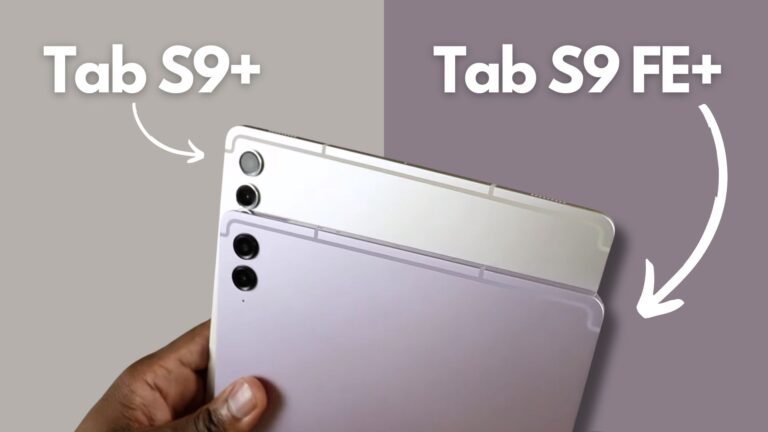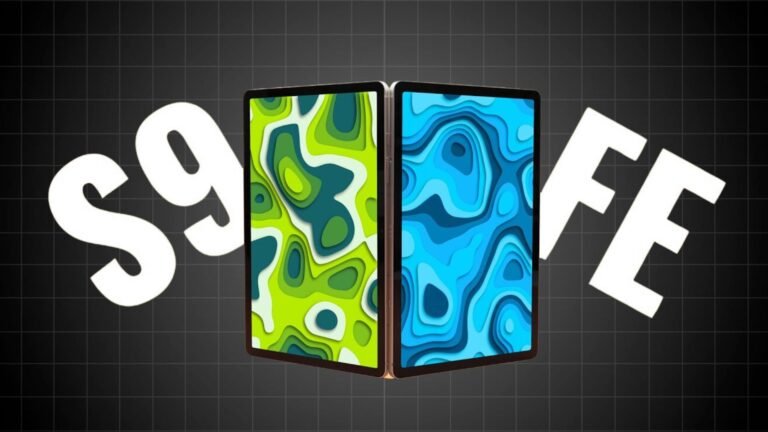It’s normal to expect a product to get better when it’s upgraded by a company. Some features may have remained the same, but none were expected to be worse. It’s possible that this isn’t the case in this instance. Astonishingly low prices for the Tab A8 and Tab A7 are also part of this surprise.
DESIGN
You might not be able to tell the difference between the two at first glance, but the Tab A7 is slightly longer and narrower. If you’re purchasing an accessory such as a case, make sure you get the correct one because they’re not interchangeable.
Both tablets have rounded corners and a rounded back edge, but the Tab A8’s curve radius is smaller, which I believe makes it look nicer. The black edge on the Tab A8’s top is also slightly thinner, making the bezels appear smaller. In comparison to the slightly jagged corners on a Tab A7, the display’s rounded corners are nicely curved.
Looking around the edges, both tablets have power and volume controls on the right, a USB-C port on the bottom, four speaker grills for the quad speaker system, a 3.5 millimeter headphone jack, and a micro SD card slot that can expand internal storage by up to one terabyte.
The front-facing camera is located on the display’s long edge and can be used for authentication with the optional facial recognition feature.
DISPLAY
Although the display sizes are nearly identical (10.5 inches on the Tab A8 vs. 10.4 inches on the Tab A7), the resolution is lower (1920 by 1200 vs. 2000 by 1200), and the aspect ratio is 16:10 vs. 5:3. We also have a lower pixel density of 216 PPI compared to 224 PPI.
When using these tablets, the differences in resolution or pixel density aren’t noticeable, but I’m surprised that Samsung didn’t make a bigger leap forward with the display after a year and a half. I wasn’t expecting the Tab S7+ SUPER AMOLED display, but I was hoping for something a little better than what we got.
When comparing the displays, I noticed that the Tab A8’s display is a little cooler or more blue, and it’s less saturated. As a result, colors don’t stand out as much.
In terms of brightness, they both measured out to be around the same peak brightness, and they both have a 60 Hertz refresh rate. You won’t notice a difference between the two if you plan on using these tablets to watch video, surf the web, take notes, work with various productivity apps, or even use social media, but when it comes to gaming, there will be some significant differences that will be tied to the new processor.
CAMERA & AUDIO SYSTEMS
Both tablets have an eight-megapixel rear camera capable of recording 1080P video at 30 frames per second. Personally, I don’t use the rear-facing cameras on any of my tablets because my phones have better cameras. As a result, I don’t place a high value on image quality on a tablet.
When it comes to the front-facing camera, both tablets have a five-megapixel camera in the middle of the long edge. When it’s mounted to a case and you’re on a video call, you’ll be framed perfectly in the center of the frame, and the camera will be nice and high off the desk.
Both tablets have a quad stereo speaker system when it comes to audio. The audio quality is also very similar, despite the fact that they don’t appear to be identical. Overall, I’m pleased with the sound quality of both. I think the Tab A8 has a slight advantage. A 3.5 millimeter headphone jack, which can be used with wired headphones or a headset, is another nice feature that they both have.
ACCESSORIES
Both tablets have enough space to accommodate a keyboard case. Remember that because the sizes differ slightly, you must purchase the appropriate case for your tablet, as they are not interchangeable. An external keyboard, such as the Logitech K480, is another option that would work well with both.
Now, neither of these are compatible with Samsung’s S-pen when it comes to using a stylist. So, if that’s something you want, you’ll have to upgrade to a higher-end model. You can always use one of those capacitive stylist options, but they don’t provide the best user experience in my opinion.
PERFORMANCE & BATTERY
Now let’s talk about processing power, which is where things get interesting because it’s a bit of a toss-up, and the benchmarks don’t always match the actual user experience.
In terms of processors, the Tab A8 uses the UNISOC Tiger T618 versus the Tab A7’s Snapdragon 662.
The Tab A8 scored 364 on single core performance compared to 316 on the Tab A7. We’re looking at 1250 versus 1405 for multi-core performance. So the Tab A8 has better single-core performance, but the Tab A7 has better multi-core performance.
Another important factor is GPU performance, which the Tab A8 outperformed the Tab A7 by a factor of 981 to 384.
When I look at my actual user experience, I find that the Tab A8 is more responsive and less sluggish for almost everything I do. Things like opening apps, switching between open apps, moving from one tab to another in the browser, and simply navigating around the UI are all better on the Tab A8.
When it comes to multitasking, the resolution of both displays is now close enough that the difference in how much you can see on the screen without scrolling is no longer significant.
The batteries in both tablets are the same size, measuring 7040 milliAmp per hour. And, as long as I don’t spend hours playing games, I can get through a full day of normal use with either.
GAMING PERFORMANCE
If you’re looking to play games that aren’t too demanding, both tablets will suffice. However, I had mixed results when I tried to play PUBG and COD Mobile.
I was able to set graphics to smooth or balanced on PUBG and then set frame rates to ultra on the Tab A8. I could only use smooth graphics and a high frame rate on the Tab A7, or balanced graphics and a medium frame rate.
When it came to COD Mobile, things went the other way, with my Tab A8 capped at medium graphic quality and high frame rate, while the Tab A7 offered the option of very high graphic quality as long as I stayed at medium frame rate. However, if I wanted a high frame rate, I had no choice but to sacrifice graphic quality.
As a result, you’ll need to decide whether graphic quality or frame rate is more important. Personally, I prefer the Tab A8 with the medium graphic quality and high frame rate.
When used with an X-Box controller and Xbox game pass, both tablets performed admirably. I was able to play all of my favorite games as long as I had a good internet connection, and the display was adequate. I did wish it was a little brighter at times, but that’s pretty much the case with any budget tablet.
PRICING & SUMMARY
So now let’s talk about the strange pricing. I’m using Samsung’s prices, but you can usually find better deals on other websites like Amazon or BestBuy.
The Tab A7 comes with either 32GB or 64GB of storage and 3GB of RAM in both models.
The Tab A8 comes with 32GB of storage and 3GB of RAM as standard, and 64GB or 128GB of storage and 4GB of RAM as an option.
The Tab A7 and Tab A8 both cost $230 for the 32GB version. And the 64GB version of both costs $280, which I don’t understand.
In the end, I find Samsung’s release to be somewhat perplexing. As a result, the budget Android tablet market continues to gain traction, especially as more people turn to online learning. Mobile gaming is becoming more popular by the day, and it’s been a year and a half since the Tab A7 was released, and the prices of both tablets are identical.
Now you should read this article to see how the Tab S7 compares with the Tab S7+, and the Tab S7 FE.








